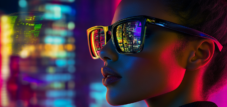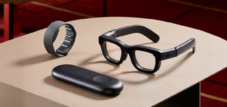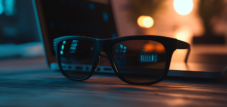Apple Glasses: What current patents reveal about the next step in augmented reality (AR)
Xpert pre-release
Language selection 📢
Published on: November 4, 2025 / Updated on: November 4, 2025 – Author: Konrad Wolfenstein

Apple Glasses: What current patents reveal about the next step in augmented reality (AR) – Creative image: Xpert.Digital
The end of the iPhone? Why Apple's new glasses could change everything
Attack on Meta: This is how Apple wants to break Ray-Ban's dominance with its glasses.
After the costly Vision Pro experiment, which, despite its technological brilliance, fell short of expectations with costs exceeding $30 billion and disappointing sales figures, Apple stands at a crucial turning point. But what appears to be a setback could prove to be the most valuable lesson for the true next step: the development of a discreet, everyday smart glass. While the Vision Pro isolated the user from their surroundings, recent patents and strategic realignments paint a clear picture of Apple's ultimate goal – a device that doesn't replace our reality, but seamlessly enriches it with digital information.
This comprehensive behind-the-scenes look reveals why the future of personal computing lies in the so-called "ambient computing" era and how Apple plans to dominate it. Based on detailed patent analyses, we examine key technologies such as waveguide optics and foveated rendering, which are expected to enable slim designs and all-day battery life. We analyze the economic prospects of a market that could grow to over $500 billion by 2035 and investigate how Apple intends to leverage its powerful ecosystem advantage to keep competitors like Meta and Google at bay. It's the story of a strategic pivot that could not only replace the iPhone as the dominant device but also usher in the next computing revolution—right before our eyes.
Apple Glasses: The next wave of digital transformation – A comprehensive economic analysis of the technological and economic perspectives of augmented reality
From a past mistake to the future of the pocket – Why smart glasses will be the computing revolution that Apple cannot afford to miss.
After years of investing in virtual reality headsets and spatial computing experiences, a fundamental realization has taken hold: the future of personal computing devices lies not in bulky head-mounted displays that isolate users from their environment, but in discreet, everyday wearables that seamlessly blend physical reality with digital information. Apple stands at a critical juncture in its corporate history. Its previous strategy with the Vision Pro has reportedly consumed up to $33 billion, while simultaneously delivering disappointing sales results well below one million units worldwide. However, this setback presents an opportunity with the potential to reposition Apple at the forefront of the next major computing paradigm shift.
The wave-like shift in personal computing: The smartphone era ends, ambient computing begins.
The history of personal computing shows a clear wave pattern, reflecting fundamental shifts in human-machine interaction. In the 1980s and 1990s, desktop computing dominated offices and homes. The revolution came with the introduction of the iPhone in 2007, which brought computing power from office desks into everyone's pocket. This shift was radical. Suddenly, everyone had access to information that had previously been tied to specific locations. The smartphone era revolutionized not only technology but also society itself.
However, since around 2015, a new phenomenon has emerged, referred to in research and industry as ambient computing. The global ambient computing market volume is estimated at at least $12.8 billion in 2025 and is projected to grow to between $96 and $449 billion by 2035. This corresponds to annual growth rates of 22 to 25 percent. While not all experts agree on their predictions, the trend is clear: computing will move from the conscious focus of attention into the background, remaining present without being overly intrusive.
The ambient computing paradigm means that technology is integrated into everyday devices and people's immediate surroundings. Instead of consciously taking a smartphone out of a pocket, unlocking it, and launching an application, in an ambient computing world this would happen through natural language input, eye tracking, or immediate environmental perception. The technology becomes an invisible layer of everyday life, providing information when needed without demanding constant attention.
Smart glasses represent the ideal pathway to this paradigm shift. Unlike smartphones, which must be taken out of the hand, and unlike head-mounted devices, which can be isolating, smart glasses look like ordinary eyeglasses. They allow for continuous proximity to digital support while enabling wearers to still see and interact with their physical surroundings. This psychological and technological difference significantly impacts market readiness.
Technological architecture as a competitive advantage: Waveguide technology and optical innovations
The basic architecture of modern AR glasses is based on a number of optical innovations, in which Apple is a leader based on its filed patents. The waveguide optics system is the key technology that enables miniaturization and everyday wearability.
A waveguide system operates on a relatively elegant principle: light is generated by the microdisplay and guided through a thin, transparent glass substrate. This waveguide lab directs the light by total internal reflection, with specially structured couplers projecting the virtual image into the human eye without obstructing clear vision of the physical world. Unlike other optical combiners such as birdbath systems or curved mirrors, the waveguide system offers significant advantages: a large viewing window, good mechanical tolerances for different head sizes, and a flat, portable form factor that actually looks like ordinary eyeglasses.
The technical challenge lies in perfecting these components. Apple's recent patents from 2024 and 2025 reveal advanced solutions to several critical problems. A patent from February 2025 describes a glass assembly with shroud elements that minimize light loss and improve structural integrity. Another patent from August 2025 addresses waveguide angle sensor measurement, suggesting that Apple is developing precise calibration systems to automatically correct the alignment between the projector and waveguides.
Such improvements may sound technically specific, but their consequences are economically significant. They reduce production waste, lower the costs of optical alignment, and increase product reliability. These are precisely the factors that determine whether a high-tech product can become a mass-market commodity or remains a luxury item.
Foveated Rendering: The key technology for energy efficiency and user comfort
Another critical innovation in Apple's patent portfolio is the miniaturization of eye-tracking systems with integrated infrared cameras and optical gratings directly in the frame of the glasses. This enables foveated rendering, a technique that has become a transformative force in the AR/VR industry.
Foveated rendering works according to the natural pattern of human vision: The center of the field of view is rendered at full resolution, while the peripheral region is displayed at reduced quality. This is due to the biological structure of the human eye: The fovea, the central area of the retina, has the highest resolution and color sensitivity, while the peripheral retina is naturally lower resolution but sensitive to movement. By replicating this asymmetry, a graphics processing unit can avoid enormous amounts of redundant processing.
Market research quantifies its importance: The foveated rendering eye-tracker market was valued at approximately $1.2 billion in 2024 and is projected to grow to between $6.4 and $10.14 billion by 2033, with annual growth rates between 20 and 29 percent. These predictions are not random. Foveated rendering offers real advantages: With identical power consumption, headsets using foveated rendering can deliver significantly higher frame rates or better image quality. For devices intended for all-day wear, battery life is a critical factor. A system that doubles or triples battery life could mean the difference between a device that is practical for the general public and one that only appeals to enthusiasts and professionals.
The economic consequences are significant. If Apple's smart glasses can achieve an eight-hour battery life through foveated rendering, combined with other optimizations such as localized data processing on the device, this would represent a massive advantage over competitors whose devices drain their batteries much faster. This is not just a luxury, but a fundamental requirement for serious market penetration.
Real-time environmental reconstruction and spatial prerequisite for credibility
One of the most subtle yet critical aspects of convincing augmented reality is the ability for virtual objects to be realistically hidden behind real-world objects. This is known as occlusion. Without occlusion, a virtual figure always appears as a hallucination hovering above the real world. With occlusion, a virtual figure can stand behind a table or wrap an arm around a real person, creating a deeper illusion of reality.
To enable occlusion, smart glasses must understand the three-dimensional geometry of their environment in real time. This requires multi-camera systems, computer vision algorithms, and spatial recognition algorithms. Apple's patents describe highly optimized systems for rapid 3D reconstruction based on simple image capture from multiple cameras, which are then combined in real time with AR recognition.
The economic significance lies in user enthusiasm and retention. Users who try the first generation of AR glasses are usually disappointed by ocular aberrations and the artificial appearance of objects. A key component in overcoming this disillusionment is a realistic spatial impression. Devices that can deliver this impression are perceived as innovative, while those that cannot are labeled as "failures."
Cloud streaming and low-latency networking: The infrastructure prerequisite
Apple's patents also point to deep integration with edge computing infrastructures and cloud systems. One of the patents explicitly mentions XR traffic optimization and low-latency streaming. This suggests that Apple is developing an architecture in which computationally intensive tasks can be dynamically distributed between the local device and cloud systems.
This is economically significant because it offers Apple a strategy to improve hardware generations without requiring massive local computing power. Instead of waiting for a chip upgrade, users could benefit from better cloud algorithms. This reduces the hardware upgrade cycle problem that has plagued the smartphone industry, where users have to switch to a new device every two to three years to keep up with performance expectations.
The global ambient computing market, projected to exceed $12 billion by 2025, will be heavily driven by this cloud symbiosis. The infrastructure component is no less important than the device itself. In fact, companies with robust cloud ecosystems—such as Apple iCloud, Amazon AWS, and Google Cloud—will have a significant advantage over hardware-only companies that lack control over a global infrastructure.
Spatial audio and biometric capture: Multisensory integration
Other technological components appearing in Apple's patents include spatial audio and biometric sensors. Spatial audio—where sounds appear to come from specific directions—is not just a convenience feature, but a core component of convincing mixed reality. When a virtual person speaks and their voice originates from their virtual position in space, not from below or to the left, spatial sound reality contributes significantly to the illusion.
Biometric sensors – heart rate, gaze direction, brainwaves – open up entirely new dimensions of human-computer interaction and authentication. Combined with AI assistants, a system could recognize whether a user is tense, bored, or focused and adjust the content accordingly. This is a quality feature that clearly distinguishes smart glasses from smartphones.
The wearable biometric monitor market was estimated at approximately $10.7 billion in 2024 and is projected to grow to approximately $25.3 billion by 2034. This signals a deep societal and technological recognition that biometric data is of interest.
The Grand Market Context: The Smartglasses Market is on the Rise
To properly contextualize the significance of Apple's smart glasses initiative, it's crucial to understand the current and projected market size for smart glasses. Various definitions and segmentations of the market exist, leading to significant discrepancies in market estimates.
According to one source, the global smart glasses market was valued at approximately $878.8 million in 2024 and is projected to grow to around $4.1 billion by 2030, with an annual growth rate of about 29 percent. Another estimate puts the AR and VR smart glasses market size at approximately $18.6 billion in 2024 and forecasts it to reach approximately $53.6 billion by 2033, with an annual growth rate of about 12 percent. The discrepancies lie in the definition – some sources count only pure AR glasses, while others also include VR and mixed reality headsets.
Regardless of the exact definition, the trend is clear: The smart glasses segment of the wearables market is one of the fastest-growing hardware categories. The overall smart wearables market is estimated to reach approximately $85.2 billion in 2025 and is projected to grow to around $506 billion by 2035.
🗒️ Xpert.Digital: A pioneer in the field of extended and augmented reality
Apple's secret bet: How smart glasses could challenge the iPhone
The Meta-Ray-Ban Strategy: The Reality Test for Consumer AR
The economic context is further intensified by the recent success of Meta with its Ray-Ban smart glasses. Meta launched these hybrid glasses—which are technically more than just cameras and AI assistants; they are more like true AR displays—and received surprisingly positive feedback. This was seen as a sales success and as validation of a large consumer market for wearable smart glasses.
The Ray-Ban Meta Glasses primarily function as a camera and voice interface to the Meta AI assistant. They are not equipped with translucent displays. Despite this, or perhaps because of it, they have been well received. This suggests that the market is waiting for devices that are simple, straightforward, and practical for everyday use, not for complex, high-tech glasses that cause stress.
The soaring sales of Ray-Ban Meta Glasses have prompted Meta and other companies to invest in smart glasses. Google announced Android XR in partnership with Samsung. Apple announced it will deliver its first smart glasses without a display in 2027 and those with displays in 2028. The competitive landscape has been completely transformed.
Apple's Ecosystem Lock-in Strategy and Competitive Advantage
A critical aspect of Apple's potential success with smart glasses is its ecosystem lock-in model. Over two decades, Apple has built an ecosystem advantage that encourages users to purchase multiple Apple devices that work together. This creates a form of digital lock-in where switching to a competitor appears inconvenient or impossible for the user.
The economic metrics clearly demonstrate this. Apple's Average Revenue Per User (ARPU) is around $140, while Google's is around $55 and Samsung's is around $40. This is a drastic difference that points to the depth of the Apple ecosystem. Users spend more money because they are more tightly integrated with Apple services across their various devices.
Smartglasses would fit perfectly into this ecosystem. Apple smartglasses could work seamlessly with an iPhone, Apple Watch, AirPods, Mac, and Apple TV. The integration could be so deep that a competing smartglass would seem less valuable because it doesn't sync with all the other devices a user already owns.
This is a form of competitive advantage that is difficult to copy. It's not enough to have a better optical chip or a faster processor. You would have to have built a very similar ecosystem network, which takes years and billions of dollars.
The Vision Pro error and lessons for smart glasses
The Vision Pro failure shouldn't be ignored, but rather used as a learning experience. While the Vision Pro was technologically impressive, it was too expensive ($3,500), too bulky, too isolating, and lacked applications beyond gaming and entertainment. Most importantly, it wasn't socially acceptable. People wearing a Vision Pro looked as if they were trying to disconnect from their surroundings. This contradicted the expectation that wearable computers should be a part of everyday life.
Smart glasses have the potential to be the opposite. They look like normal glasses or sunglasses. Wearing smart glasses doesn't signal "I'm gone into the virtual world," but rather "I'm present, but I have digital support." This is a crucial psychological difference.
Apple's pivot from Vision Pro to smart glasses is therefore not just a learning curve, but a strategic repositioning. It acknowledges that the future lies not in heavy spatial computing headsets, but in lightweight, everyday AR glasses.
Artificial intelligence as an enabler for mass-market AR
One of the strategic insights from Apple's recent announcements is the emphasis on AI and voice interaction. The smart glasses will "rely heavily on voice interaction and AI," according to Bloomberg reports. This is a smart decision.
Smartphone apps are delivered through a centralized app ecosystem—the app store. This presents a barrier for third-party developers, but it also enables quality control and curation. Smart glasses cannot use the same app model because the user interface is entirely different. Instead, interaction can be mediated by AI assistants that understand what the user wants to say and act accordingly.
This is a less restrictive model than app stores, but it is also more technically demanding. It requires high-quality natural language processing, context understanding, and predictive modeling. Apple's problems with Siri are well-known, but the company is actively working to improve it.
Regardless of Apple's current position, there is a broader industry shift toward AI-enabled smart glasses. The global AR glasses market is projected to grow to approximately $10 billion by 2030, with an annual growth rate of around 59 percent. Much of this growth is driven by AI, which enables devices to provide intelligent, voice-activated features without the need for apps or complex menus.
Enterprise applications and the B2B market as a catalyst
An often overlooked component of the smart glasses industry is the business-to-business market. While consumer AR is still in its infancy, smart glasses are already being actively used in industrial, logistics, and healthcare applications.
In manufacturing plants, employees wearing smart glasses can see information about a part simply by looking at it. In warehouses, order pickers can be guided by Magliern instructions without needing to carry a separate paper list or handheld device. In medicine, surgeons can overlay real-time data onto their screens during an operation.
These business applications are driving massive market dynamics. The AR glasses market is projected to grow to approximately $10 billion by 2030, with annual growth of around 59 percent, largely driven by enterprise applications. The broader industrial wearables market is fueled by the same drivers: efficiency gains, reduced errors, and improved security.
For Apple, a successful smartglasses initiative would therefore not be limited to the consumer market. It could also be an entry point into the enterprise markets, which have so far been dominated by specialized device manufacturers. This would expand Apple's overall market size and open up new revenue streams.
The core problem and the competitive landscape: Who can win?
While Apple's technical capabilities are undeniable, the competition is formidable. Meta already has an established position with Ray-Ban smart glasses and is working on full AR displays for 2027. Google is collaborating with Samsung and others on Android XR. Microsoft has an enterprise-level position with HoloLens. Specialist companies like Vuzix and Magic Leap possess years of technical experience.
The competition is fierce, but not insurmountable for Apple. In fact, Apple has succeeded in similar situations. The company wasn't the first to manufacture smartphones or tablets, but it dominated through superiority in design, integration, and user experience. The same formula could apply to smart glasses.
However, there are also significant uncertainties. The exact timing – will Apple deliver in 2027 or later? – also has economic consequences. If Meta or Google bring their products to market faster and build a defensive advantage with a large installed base, Apple's delay could be detrimental.
Global Market Forecasts and Growth Drivers
The projected global growth momentum for all AR/VR and wearables is impressive. The global wearables market is expected to grow from approximately $85 billion in 2025 to approximately $506 billion in 2035. The smart wearables segment will account for a significant portion of this growth.
Geographically, growth will be fastest in the Asia-Pacific region, driven particularly by China. China already has over 800 pilot projects for smart city implementations, and many of these projects could be supported by AR applications. Japan and South Korea are leaders in smart eyewear technology. This means that competition will also be intense globally.
In North America, growth is driven by early technology adoption and strong infrastructure investment. In Europe, data privacy concerns and regulatory requirements are key factors shaping implementation.
Network infrastructure and edge computing as limiting factors
A critical component that is often underestimated in technical discussions is network infrastructure. Most modern AR applications require fast, stable connectivity. 5G offers the bandwidth and latency to enable this, but 5G infrastructure is not ubiquitous, and the costs of global deployments are substantial.
Research into 5G for XR applications has shown that 5G networks can indeed offer sufficient bandwidth and low latency for XR applications. Maximum bandwidth reached approximately 190 megabits per second, and latency between the headset and edge servers ranged from 30 to 80 milliseconds. These figures are sufficient for many applications.
However, there is a problem: the actual rollout of 5G is still limited. In many countries, especially developing countries, there are still large areas without 5G coverage. This means that smart glasses, which rely heavily on cloud connectivity, could be less attractive in these regions.
This is a structural problem that cannot be solved quickly. It also suggests that successful smartglass implementations will occur more rapidly in developed countries and cities than in less developed regions. This could create an asymmetric market dynamic.
Perseverance and long-term perspective: The difference between hype and reality
The history of wearables is one of hype and disappointment. Smartwatches were long proclaimed as "the next big thing" but achieved only limited consumer adoption. Fitness trackers experienced a boom followed by a decline, with many users abandoning the devices after 6 to 18 months.
This doesn't mean that smart glasses won't be successful. It simply means that building a technologically advanced device isn't enough. The device must offer clear, everyday added value for the end user. It must be easy to use. It must be comfortable to wear all day. And it must fit into a social context where wearers aren't seen as eccentric.
Apple's recent announcements suggest that the company has learned these lessons. By focusing on simple, glasses-like form factors and AI interaction rather than fully immersive mixed reality, Apple is positioning itself on a more pragmatic path to the mass market.
The transition from smartphone to the next generation: economic implications for Apple
A critical strategic point is that smart glasses will not necessarily replace smartphones, but rather complement them and eventually displace them. This has massive economic implications for Apple, which is currently heavily reliant on iPhone sales.
In the first phase, smart glasses could function as complementary devices, representing more expensive wearables. This would open up a new revenue stream. In a second phase, as smart glasses become more advanced and cheaper, they could become the primary consumer device for many users, even replacing the smartphone.
This is a disruptive scenario for Apple. The iPhone remains the company's financial powerhouse. If smart glasses were to displace the iPhone, Apple would need to ensure that the smart glasses are as profitable as the iPhone—or more so. This is not guaranteed. Smart glasses hardware could be cheaper than smartphones, which could mean lower margins unless Apple can monetize services that generate more value.
This is likely Apple's strategy. The company has already driven 25 percent of its total revenue from services and aims to grow them at an annual rate of around 25 percent. This services revenue could be transferred to smart glasses, encompassing content, cloud storage, and other digital services that go beyond hardware sales.
Economic perspective: The potential and the risks
Apple's smart glasses initiative is not just a technological endeavor, but a strategic pivot that will define the company's next decade. The technological foundation is in place—patents indicate that Apple has achieved genuine technological breakthroughs in optics, eye tracking, and spatial audio. The market landscape is favorable—the global wearables and AR industry is growing at double-digit to high-twenties percent annually.
However, the risks are also real. Apple is late to the game – Meta and Google are already on the market. The technology is still not fully mature, and consumer acceptance is uncertain. The competition is intense and well-capitalized.
Nevertheless, Apple has historically proven that it doesn't have to be first, but it can achieve dominant positions through superiority in design, integration, and user experience. If the company applies these advantages to smart glasses, it could create a massively profitable and transformative new product class that defines the next chapter in personal computing history. The risk is that the delay is too long, allowing competitors to secure a dominant position. The next two to three years will be crucial.
Your global marketing and business development partner
☑️ Our business language is English or German
☑️ NEW: Correspondence in your national language!
I would be happy to serve you and my team as a personal advisor.
You can contact me by filling out the contact form or simply call me on +49 89 89 674 804 (Munich) . My email address is: wolfenstein ∂ xpert.digital
I'm looking forward to our joint project.
☑️ SME support in strategy, consulting, planning and implementation
☑️ Creation or realignment of the digital strategy and digitalization
☑️ Expansion and optimization of international sales processes
☑️ Global & Digital B2B trading platforms
☑️ Pioneer Business Development / Marketing / PR / Trade Fairs
🎯🎯🎯 Benefit from Xpert.Digital's extensive, five-fold expertise in a comprehensive service package | BD, R&D, XR, PR & Digital Visibility Optimization

Benefit from Xpert.Digital's extensive, fivefold expertise in a comprehensive service package | R&D, XR, PR & Digital Visibility Optimization - Image: Xpert.Digital
Xpert.Digital has in-depth knowledge of various industries. This allows us to develop tailor-made strategies that are tailored precisely to the requirements and challenges of your specific market segment. By continually analyzing market trends and following industry developments, we can act with foresight and offer innovative solutions. Through the combination of experience and knowledge, we generate added value and give our customers a decisive competitive advantage.
More about it here:





















